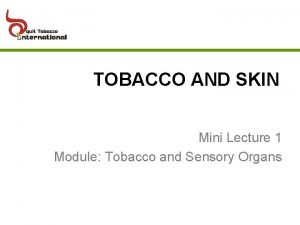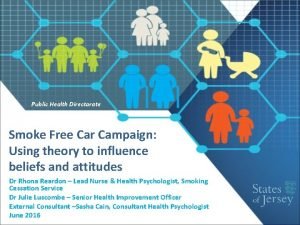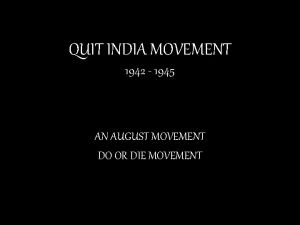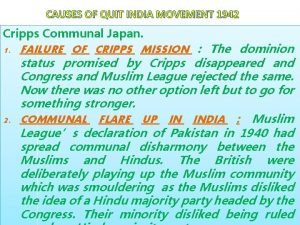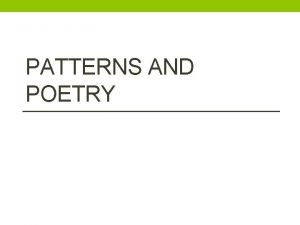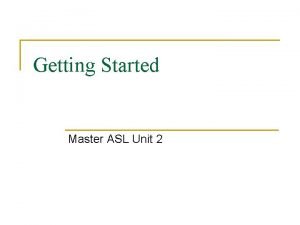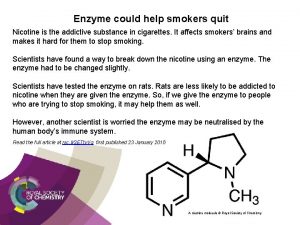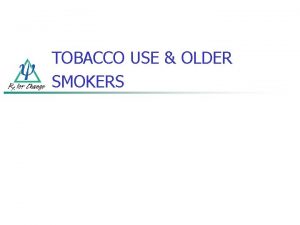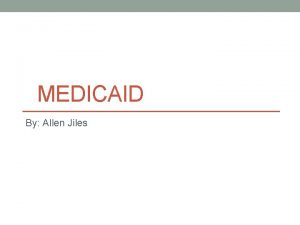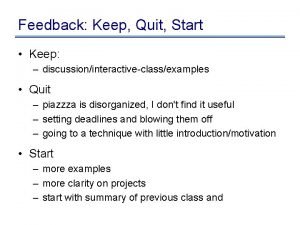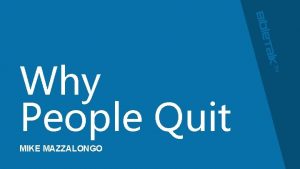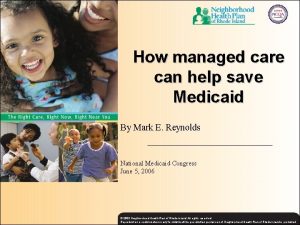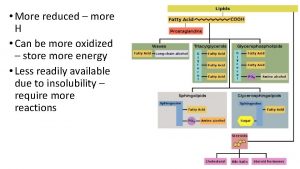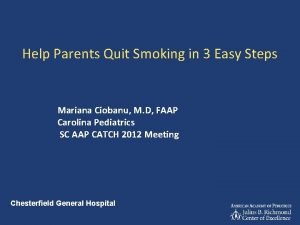Medicaid Can Do More to Help Smokers Quit




























- Slides: 28

Medicaid Can Do More to Help Smokers Quit Leighton Ku, Ph. D, MPH Professor, Health Policy & Management October 2016

Background • Smoking: #1 preventable cause of morbidity and mortality • About 32% of Medicaid enrollees smoke. Twice the rate of the general population (17%) [2014 NHIS] • Medicaid: largest insurance program in the US, serving about 70 million. Still growing due to ACA. • About 15% of Medicaid expenditures due to smoking. About $75 billion in 2016. • 1998 Master Settlement Agreement: tobacco industry paid over $200 billion to states due to high Medicaid costs. • National health objectives to reduce smoking include expanding smoking cessation coverage in Medicaid.

Big Picture: Insurance & Prevention • US spends more than $3 trillion for health care and insurance, mostly for acute care after problems occur. • Insurance pays medical bills and define what is covered. Key concept is “medical necessity” based on a diagnosis. • Historically, prevention services sometimes not covered because there was no diagnosis of an illness. • Insurers also worry that prevention might not lower cost burden in that year. • Prevention services gradually added. ACA required coverage for effective prevention services (e. g. , vaccinations, contraception, smoking cessation).

Massachusetts Tobacco Cessation • In 2006, MA began a comprehensive Medicaid cessation benefit, coupled with an outreach plan, including quitlines. • Land et al (2010 a) found smoking prevalence fell by about from 38% to 28%. • Land et al (2010 b) found the rate of cardiovascular hospitalizations among users fell by a third to half. • # of CVD deaths due to smoking exceeds lung-related. • Richard et al (2012) found that every $1 spent on cessation benefits was associated with about $3 in lower Medicaid hospital costs. A $2 return on investment.

Medicaid Coverage Policies • As of 2014, all states cover some tobacco cessation drugs and counseling. Not just for pregnant women. Often have barriers like copayments or prior authorization. • Many physicians & patients not aware of benefits. Use of counselling appears uncommon. • CDC collects info about tobacco coverage, but little known about use of benefits. • Broad aims: to assess state Medicaid efforts in smoking cessation and why states differ, how these are associated with actual smoking behavior and how to bolster smoking cessation.

FDA Approved Cessation Medications • Most smokers want to quit and try but relapse. Repeated attempts often needed. Medications increase quit rates. Help reduce craving for tobacco to ease withdrawal. • Nicotine Replacement Therapies (NRTs): patch, gum, lozenge (available over the counter and with prescription), plus spray and inhaler. • Bupropion (Zyban) use both for smoking cessation and as antidepressant. • Varenicline (Chantix). Brand name drug. Considered more effective, but more expensive. • E-cigarettes not approved, but many use to help quit.

How Do Policies Translate Into Benefits and Quitting? Other Policies: CMS Physicians Providers State Medicaid Managed Care Plans CDC State Public Health Pharmacies Counselors Cig Taxes, Smokefree Patient Activated & Receives Medications or Counseling Quitlines Direct Public Education Quits & Health Outcomes

Medicaid Drug Utilization Data • Every 3 months states submit a complete list of medications Medicaid bought with specific drug data (NDC code), prescriptions, units and amounts paid. • Medicaid drug rebate system, over $16 billion/yr. • We extracted data for FDA-approved medications. • Bupropion sometimes used as anti-depressant. Hard to isolate purpose of prescription. Smoking and depression are linked. We limited data to 150 mg 12 hr dosage, which is most commonly used for cessation. • Before 2010, only FFS drugs. After 2010, also included managed care drugs.

Other Data • Drug utilization data is aggregate. No data about characteristics of users. • Medicaid claims data are available, but unwieldy and slow. Often exclude managed care data. Do not show who is smoker or not. • Drug utilization data show the numerator of use of medications, but not how many might need help. • Used annual Kaiser data about Medicaid enrollment of adults, aged and blind/disabled • Used annual BRFSS data about percent of low-income insured adults who smoke in each state

Volume and Cost of Medications, 2013 1. 7 Million Prescriptions 34% Bupropion 50% 16% $103 Million in Payments (Before Rebates) 28% 23% Varenicline Bupropion Varenicline 3 Nicotine Replacement 49% 3 Nicotine Replacement Although smoking costs Medicaid ~ $75 billion a year, only about $100 million is spent on smoking cessation meds.

Prevalence of Smoking in Medicaid # Medicaid Adults (mil. )(a) % Current Smokers (b) # Est. Adult Medicaid Smokers (mil. ) 2010 2011 2012 2013 25. 0 26. 1 26. 9 27. 6 33% 34% 32% 30% 8. 2 8. 9 8. 5 8. 3 (a) Kaiser State Health Facts (b) Behavioral Risk Factor Surveillance System

Tobacco Cessation Utilization Prescriptions Per Smoker Per Year Est % of Medicaid Smokers Receiving Medications (a) Est # of Smokers Receiving Medications (1, 000 s) 2010 2011 2012 2013 0. 183 0. 206 0. 201 9. 2% 10. 1% 10. 3% 10. 0% 747 896 877 834 (a) Assumes an average of two prescriptions person per year.


Most States Can Do More • Large differences in utilization across states: from high of. 53 prescriptions/user in MN (~27% of smokers) to. 01 in TX (<1% of smokers) • Most states could do more to promote smoking cessation in Medicaid. • There also differences in prevalence of smoking. No clear correspondence of smoking prevalence and cessation utilization. • We don’t know why these differences exist and are beginning to explore this. Having Medicaid and public health agencies give priority to this is a good start.

Medicaid Expansion vs Non-Expansion 2013 U. S. Total Expanding States (b) Nonexpanding States (b) % Medicaid Adults Who Smoke # Medicaid Smokers Cessation Prescriptions per Smoker % Smokers Receiving Meds (a) 30% 25% 8. 3 mil. 5. 7 mil. 0. 20 0. 23 10% 12% 36% 2. 6 mil. 0. 14 7% (a) Assumes 2 prescriptions per smoker per year (b) Based on 30 expanding states planned as of June 2015

Expansion vs Non-Expansion • We don’t believe non-expansion policies cause more smoking or less use of cessation medications. • But there are public health consequences. Non-expanding states have higher smoking prevalence, lower cessation utilization and fewer people will get access to cessation assistance through Medicaid. • Could lead to growing gap in tobacco-related health burdens across the states.

State Policies & Collaborations • Triple Aim: improve patient experience, cost control and population health. • Medicaid tobacco cessation should be low hanging fruit. A joint responsibility of Medicaid and public health. Often in the same department. • Medicaid generally covers cessation benefits already. • Examples of strong state initiatives involved Medicaid public health collaborations. • But agencies are typically in silos, with separate jurisdictions even when they are in the same department.

Factors Affecting Cessation Utilization • Determinants of medication use (prescription fills per smoker) for every state from 2010 -14 (n= 5 * 51) • Traditional analyses based on coverage policies, but they might not be main determinants. • Independent variables included: – Medicaid coverage of NRTs, bupropion, varenicline – Coverage restrictions (copays, preauthorization, requirement for counseling) – Cigarette taxes, smoke-free laws – Overall smoking prevalence – Quitline medication availability

Methods and Findings • Use panel data methods with two-way fixed effects. Control for unmeasured state factors and secular changes. • Broader selection of medications associated with greater use. • Requiring counseling associated with less use. • No significant effects of: – Copayments or prior authorization – Cigarette taxes, smoke-free laws, general smoking prevalence – Quitline medications

Limitations & Issues • Could not account for special state initiatives • Tested variants due to measurement uncertainties about managed care policies and medications (bupropion). Findings are robust and consistent. • Somewhat puzzled by lack of significant effects of copayments, cigarette taxes, smokefree laws.

Case Study Project • Interviewed Medicaid & public health staff in 8 states to ask about collaborations in late 2015/early 2016. • All health agencies have tobacco control units. Identified public health staff thru Tobacco Control Network. • Harder to identify key Medicaid staff. Agency staff often did not know counterparts. Sometimes involved medical director, quality, pharmacy benefits staff. • Asked about interagency collaborations, development of Medicaid policies, monitoring and quitlines.

Case Study States % Smokers Receiving % Medicaid Cessation Adults Who Medications, Smoke, 2013 Alabama 37% 4% Arkansas 41% 3% Delaware 34% 4% Kansas 35% 3% Minnesota 35% 27% New Hampshire 38% 25% Oregon 37% 20% Rhode Island 36% 2% Medicaid Expansion State (as of Sept. 2015) no yes yes yes Region South Northeast Midwest Northeast West Northeast

Not Much Collaboration • Generally little or no collaboration. No joint projects. • Limited high level or external leadership. • Medicaid agencies developed coverage policies without input from health dept. • Public health agencies operated tobacco prevention and education programs, but not really focused on Medicaid. • Main area of interaction was quitlines, run by health dept, • Some wanted Medicaid funding. Many callers are Medicaid recipients. Usually did not get Medicaid funding.

Example of Different Mindsets • In Minnesota, Medicaid said it covered quitline medications. Quitline disagreed and it got no support. • Discrepancy explained by what “coverage” means • Medicaid had policy to pay for medications provided by quitline to Medicaid beneficiaries if quitline used an approved pharmacy. Had done so in the past. • Quitline changed contractor. New contractor did not have approved pharmacy. • To Medicaid “coverage” meant there was a policy to pay under right circumstances. • To quitline, “coverage” meant Medicaid actually pays.

What Can States Do? • We are still in progress to understand why some states are doing better than others. • Ultimate goals are to encourage providers to help with cessation (5 As) and engage patients to quit successfully. • But a first step is to make smoking cessation a priority for Medicaid, managed care organizations and to work with public health agencies. • Another step is to begin to develop measures to monitor efforts and outcomes. • CDC and CMS beginng to encourage states to focus on smoking cessation, particularly thru CDC’s 6|18 Initiative.

Thinking More Broadly • Triple Aim for health policy: (1) improve patient experience of care (quality and satisfaction), (2) limit health care costs and (3) improve population health. • How can we better align health care policy goals with public health goals? • Can health policy and public health officials work together to improve population health? What are roles of primary (community) and secondary (clinical) prevention? • How can we increase engagement by clinicians, patients and communities?

Support • Supported by National Cancer Institute grant R 15 CA 176600 and Robert Wood Johnson Evidence 4 Action grant.

References • Ku, L. , Brantley, E. , Bysshe, T. , Steinmetz, E. , Bruen, B. How Medicaid and Other Public Policies Affect Utilization of Tobacco Cessation, Preventing Chronic Diseases, 2016. • Ku L, Bruen B, Steinmetz E & Bysshe T. Medicaid Tobacco Cessation: Big Gaps Remain in Efforts to Get Smokers to Quit, Health Affairs, 2016 Jan. 35(1) • Richard P, West K & Ku L. The Return on Investment of a Medicaid Tobacco Cessation Initiative in Massachusetts. PLo. S One. 2012; 7(1).
 Lirik lagu more more more we praise you
Lirik lagu more more more we praise you More more more i want more more more more we praise you
More more more i want more more more more we praise you Smokers skin
Smokers skin Who are second hand smokers
Who are second hand smokers Dr trisha pachiano
Dr trisha pachiano Smokers radiation
Smokers radiation I can quit anytime i want
I can quit anytime i want Quit game quiz
Quit game quiz The day the crayons quit summary
The day the crayons quit summary Quit yourselves like a man
Quit yourselves like a man Todd is trying to quit cheating
Todd is trying to quit cheating Quit that shit
Quit that shit But 'tis strange and oftentimes
But 'tis strange and oftentimes Quit now maryland
Quit now maryland Pringud
Pringud Great wall of china golden ratio
Great wall of china golden ratio Impact of quit india movement
Impact of quit india movement Cause of quit india movement
Cause of quit india movement Quit salariale
Quit salariale Freesurfer troubleshooting
Freesurfer troubleshooting I m being oppressed
I m being oppressed Helper chapter 1
Helper chapter 1 Self help and community help is the motto of
Self help and community help is the motto of Help us help you
Help us help you Asl sentences examples
Asl sentences examples 5 apples in a basket riddle
5 apples in a basket riddle The more you study the more you learn
The more you study the more you learn Aspire not to
Aspire not to Newton's first law example
Newton's first law example


